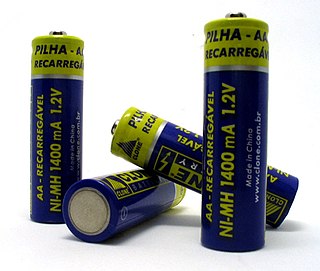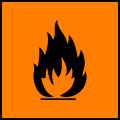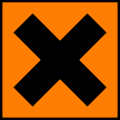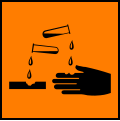
A safety data sheet (SDS), material safety data sheet (MSDS), or product safety data sheet (PSDS) is a document that lists information relating to occupational safety and health for the use of various substances and products. SDSs are a widely used type of fact sheet used to catalogue information on chemical species including chemical compounds and chemical mixtures. SDS information may include instructions for the safe use and potential hazards associated with a particular material or product, along with spill-handling procedures. The older MSDS formats could vary from source to source within a country depending on national requirements; however, the newer SDS format is internationally standardized.

Hazard symbols or warning symbols are recognisable symbols designed to warn about hazardous or dangerous materials, locations, or objects, including electromagnetic fields, electric currents; harsh, toxic or unstable chemicals ; and radioactivity. The use of hazard symbols is often regulated by law and directed by standards organizations. Hazard symbols may appear with different colors, backgrounds, borders, and supplemental information in order to specify the type of hazard and the level of threat. Warning symbols are used in many places in place of or in addition to written warnings as they are quickly recognized and more universally understood, as the same symbol can be recognized as having the same meaning to speakers of different languages.
Risk and Safety Statements, also known as R/S statements, R/S numbers, R/S phrases, and R/S sentences, is a system of hazard codes and phrases for labeling dangerous chemicals and compounds. The R/S statement of a compound consists of a risk part (R) and a safety part (S), each followed by a combination of numbers. Each number corresponds to a phrase. The phrase corresponding to the letter/number combination has the same meaning in different languages—see 'languages' in the menu on the left.

The European Community number is a unique seven-digit identifier that was assigned to substances for regulatory purposes within the European Union by the European Commission. The EC Inventory comprises three individual inventories, EINECS, ELINCS and the NLP list.

The Globally Harmonized System of Classification and Labelling of Chemicals (GHS) is an internationally agreed-upon standard managed by the United Nations that was set up to replace the assortment of hazardous material classification and labelling schemes previously used around the world. Core elements of the GHS include standardized hazard testing criteria, universal warning pictograms, and safety data sheets which provide users of dangerous goods relevant information with consistent organization. The system acts as a complement to the UN numbered system of regulated hazardous material transport. Implementation is managed through the UN Secretariat. Although adoption has taken time, as of 2017, the system has been enacted to significant extents in most major countries of the world. This includes the European Union, which has implemented the United Nations' GHS into EU law as the CLP Regulation, and United States Occupational Safety and Health Administration standards.

The Directive 2006/66/EC of the European Parliament and of the Council of 6 September 2006 on batteries and accumulators and waste batteries and accumulators and repealing Directive 91/157/EEC, commonly known as the Battery Directive, regulates the manufacture and disposal of batteries in the European Union with the aim of "improving the environmental performance of batteries and accumulators".

The Control of Substances Hazardous to Health Regulations 2002 is a United Kingdom Statutory Instrument which states general requirements imposed on employers to protect employees and other persons from the hazards of substances used at work by risk assessment, control of exposure, health surveillance and incident planning. There are also duties on employees to take care of their own exposure to hazardous substances and prohibitions on the import of certain substances into the European Economic Area. The regulations reenacted, with amendments, the Control of Substances Hazardous to Work Regulations 1999 and implement several European Union directives.
The European Chemicals Bureau (ECB) was the focal point for the data and assessment procedure on dangerous chemicals within the European Union (EU). The ECB was located in Ispra, Italy, within the Joint Research Centre (JRC) of the European Commission. In 2008 the ECB completed its mandate. Some of its activities were taken over by the European Chemicals Agency (ECHA); others remained within the Joint Research Centre. The history of the ECB has been published as a JRC technical report.

The CLP Regulation is a European Union regulation from 2008, which aligns the European Union system of classification, labelling and packaging of chemical substances and mixtures to the Globally Harmonised System (GHS). It is expected to facilitate global trade and the harmonised communication of hazard information of chemicals and to promote regulatory efficiency. It complements the 2006 Registration, Evaluation, Authorisation and Restriction of Chemicals (REACH) Regulation and replaces an older system contained in the Dangerous Substances Directive (67/548/EEC) and the Dangerous Preparations Directive (1999/45/EC).

Council Directive 76/768/EEC of 27 July 1976 on the approximation of the laws of the Member States relating to cosmetic products was the main European Union law on the safety of cosmetics. It was made under Art. 100 of the Treaty of Rome. By agreement, it was also applicable in the European Economic Area.

The Dangerous Preparations Directive is a European Union directive in the field of occupational safety and health and consumer protection. It complements the Dangerous Substances Directive (67/548/EEC) and replaces a previous Dangerous Preparations Directive (88/379/EEC). The European Court of Justice had ruled in 1985 that Dangerous Substances Directive (67/548/EEC) applies only to pure substances, not preparations.
Hazard statements form part of the Globally Harmonized System of Classification and Labelling of Chemicals (GHS). They are intended to form a set of standardized phrases about the hazards of chemical substances and mixtures that can be translated into different languages. As such, they serve the same purpose as the well-known R-phrases, which they are intended to replace.
Hazard pictograms form part of the international Globally Harmonized System of Classification and Labelling of Chemicals (GHS). Two sets of pictograms are included within the GHS: one for the labelling of containers and for workplace hazard warnings, and a second for use during the transport of dangerous goods. Either one or the other is chosen, depending on the target audience, but the two are not used together for the same hazard. The two sets of pictograms use the same symbols for the same hazards, although certain symbols are not required for transport pictograms. Transport pictograms come in wider variety of colors and may contain additional information such as a subcategory number.

Musk xylene is a synthetic musk fragrance which mimics natural musk. It has been used as a perfume fixative in a wide variety of consumer products, and is still used in some cosmetics and fragrances.
European hazard symbols for chemicals are pictograms defined by the European Union for labelling chemical packaging and containers. They are standardised currently by the CLP/GHS classification.

Methyl eugenol (allylveratrol) is a natural chemical compound classified as a phenylpropene, a type of phenylpropanoid. It is the methyl ether of eugenol and is important to insect behavior and pollination. It is found in various essential oils.
Technical Guidance WM2: Hazardous Waste: Interpretation of the definition and classification of hazardous waste is a guidance document developed and jointly published by the English Environment Agency, Natural Resources Wales, Scottish Environment Protection Agency and the Northern Ireland Environment Agency to provide guidance on the assessment and classification of hazardous waste based on the revised Waste Framework Directive definition of hazardous waste. Waste producers, consultants, contractors and waste management companies use the guidance to a) identify the correct waste code for their waste and b) determine whether the waste is hazardous or not based on its chemical composition.

The Directive 92/58/EEC specifies the minimum requirements for safety signs within the European Union. It superseded the Directive 77/576/EEC. While not being replaced by the standard ISO 7010, both signage systems can be used. This directive does not apply to signage used for controlling roadway, railway, waterway or air transportation.
















